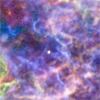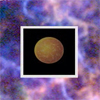CXC Home | Search | Help | Image Use Policy | Latest Images | Privacy | Accessibility | Glossary | Q&A
Tour of Cassiopeia A
Quicktime MPEG
Cassiopeia A is a supernova remnant found embedded in the constellation that bears its name, which is known as the queen in Greek mythology. Along with virtually all modern telescopes, the Chandra X-ray Observatory has devoted a great deal of time to examine this aftermath of an exploded star. The latest results from Chandra reveal new details about the neutron star, which is the ultra-dense core of the star that exploded. For the first time, astronomers have determined that this stellar nub has an incredibly thin atmosphere of carbon on its surface. This is an important clue in deducing the true nature of this mysterious source which lies at the center of one of astronomy's most famous objects.
[Runtime: 00:41]
Quicktime MPEG
Cassiopeia A is a supernova remnant found embedded in the constellation that bears its name, which is known as the queen in Greek mythology. Along with virtually all modern telescopes, the Chandra X-ray Observatory has devoted a great deal of time to examine this aftermath of an exploded star. The latest results from Chandra reveal new details about the neutron star, which is the ultra-dense core of the star that exploded. For the first time, astronomers have determined that this stellar nub has an incredibly thin atmosphere of carbon on its surface. This is an important clue in deducing the true nature of this mysterious source which lies at the center of one of astronomy's most famous objects.
[Runtime: 00:41]
(Credit: X-ray: NASA/CXC/Southampton/W. Ho et al.; Illustration: NASA/CXC/M.Weiss.)
Chandra Image and Artist's Illustration of Neutron Star
Quicktime MPEG
The point-like source at the center of supernova remnant Cassiopeia A has been known to astronomers for over a decade. New research suggests this neutron star is coated with a carbon atmosphere only four inches thick. This carbon atmosphere has a density similar to a diamond and a pressure more than ten times that found at the center of the Earth. This discovery made with data from Chandra is the first time the composition of an atmosphere of an isolated neutron star has been confirmed.
[Runtime: 00:16]
Quicktime MPEG
The point-like source at the center of supernova remnant Cassiopeia A has been known to astronomers for over a decade. New research suggests this neutron star is coated with a carbon atmosphere only four inches thick. This carbon atmosphere has a density similar to a diamond and a pressure more than ten times that found at the center of the Earth. This discovery made with data from Chandra is the first time the composition of an atmosphere of an isolated neutron star has been confirmed.
[Runtime: 00:16]
(Credit: X-ray: NASA/CXC/Southampton/W. Ho et al.; Illustration: NASA/CXC/M.Weiss.)
Return to Cassiopeia A (November 4, 2009)




